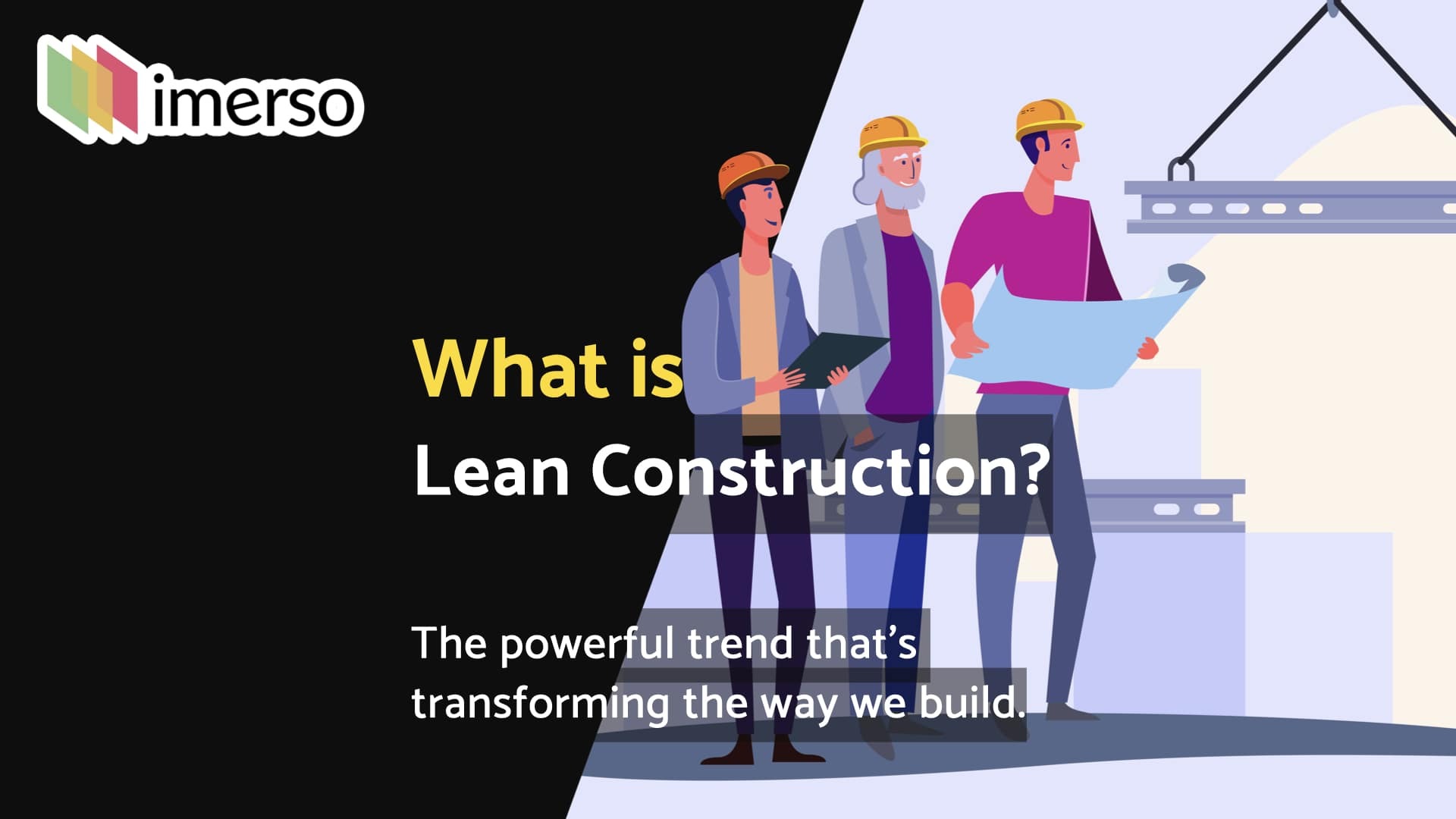TL;DR
- Lean Construction recognises that not everything can be planned in detail from the start and proposes a “plan as you go" principle which is more flexible and effective.
- Collaboration-oriented project models are the key. Integrated Project Delivery (IPD) emphasises the importance of team collaboration and ensuring that everyone involved has a vested interest in the project's overall success, rather than in individual short-term gains.
- Tools like Takt Planning will help your teams keep a steady, repeatable work rhythm, while methods such as the Last Planner System® advocates for close input from the Last Planners and involves them in detailed activity scheduling.
- BIM & 3D Scanning can help get everyone on the same page about the work plans and the real as-built conditions at the site. Tools like Imerso enable easy sharing of this data, as well as automatic analysis of how well the onsite work is following the BIM plans.
- Small work batches and prefabrication allow you to optimise for repetition and productivity by dividing work sequences into smaller batches. Leveraging off-site fabrication and prefabricated elements can enhance trade flow.
Contents
Planning tools based on Lean Construction principles:
1. Planning is carried throughout the construction project — Not just at the start
2. Delivery model — Set the right incentives for collaboration
3. The Last Planner System® — Empower your experts
4. The Takt Planning method -- Stay on the beat
5. BIM & 3D Scanning — Get everyone on the same page
6. Small work batches and prefabrication
What is Lean Construction?
In modern construction, project planning has undergone a significant evolution. The conventional approaches, once rooted in rigid structures and linear methodologies, have given way to a more agile, efficient, and collaborative framework known as Lean Construction.
Lean Construction isn't just a methodology. It's a philosophy derived from the lean manufacturing principles pioneered by Toyota in the 1950s. Lean Construction seeks to eliminate waste, maximise value, and foster continuous improvement throughout every stage of a construction project.
At its core, Lean Construction challenges the traditional notions of project planning by emphasising the need for streamlined processes, enhanced communication, and a profound understanding of client needs. It requires a shift from the traditional “plan then build" mindset to a more integrated, collaborative, and adaptive approach that values flexibility and responsiveness. Read more about the origins and benefits of Lean Construction methods.
Let's dive into some of the most innovative project planning techniques based on Lean Construction principles. Here we go!
Take the free tour of Imerso Construction AI to elevate work quality at your construction sites. >>
1. Planning takes place throughout the project — Not just at the start
The traditional approach to planning would be to outline the entire project as much as possible from the get-go, creating rigid work schedules and pushing all tasks to meet those deadlines. There are always problems with such planning when hoping that everyone does what they're supposed to do.
Lean Construction recognises the reality that not everything can be planned in detail from the start — in fact, it embraces that the best plan must include space to “plan as you go”. Hence, the Planning stage is not the start of a waterfall sequence that runs all the way to completion, but rather the first stage in a recurring cycle.
At the same time, Lean emphasises the need for a proper plan, and that early efforts can have the maximum impact for the lowest cost. To embrace Lean Construction and continuous improvement, it's time to start thinking in cycles instead of linear sequences.
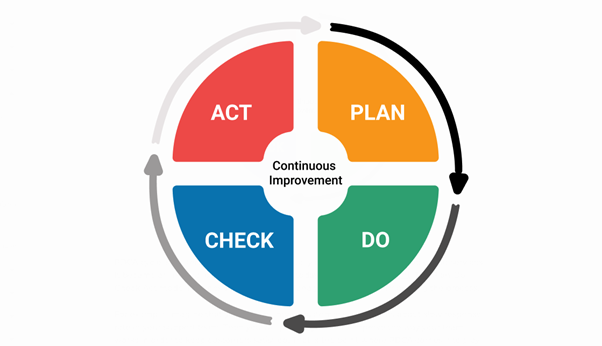
2. Delivery model — Set the right incentives for collaboration
One of the most critical aspects of successful Lean projects is to enable your teams to function as a single unit. This is more than just setting good wishes and intentions: you must find a collaboration-oriented project model for your contracts.
Firstly, consider a model where the main effort of your teams is put at the early stages, where changes are easier and less costly. This enables your teams to optimise their processes at a time when the impact on costs is the highest. Sub-optimised processes that require modifications at later stages of the project will carry higher costs and will be much harder to accommodate, given their multiple dependencies to other tasks already in progress.
You can also implement an incentive scheme where all participants stand to gain or lose based on their performance as a team.
Popular approaches of Integrated Project Delivery (IPD) seek to establish a Base Target Cost early in the validation phase, then create Innovation Incentives for the parties to profit from lowering that cost during the design stage and achieve a Final Target Cost. Then at completion, distributing losses or gains across the teams based on the project having beaten or underperformed against that target.
This approach emphasises the importance of team collaboration and ensures that everyone involved has a vested interest in the project's overall success, rather than focusing solely on individual short-term gains. By implementing such mechanisms, all parties are motivated to work together towards a common goal, fostering a sense of shared responsibility and accountability.
Then, provide training in methods like Takt Planning and the Last Planner System (described below) so that your teams focus on optimising what matters while planning as they go.
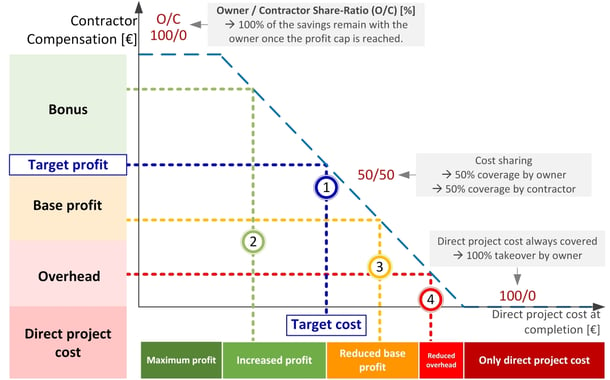
3. The Last Planner System® — Empower your experts
The title of this approach is very intentional: this system advocates that running effective construction projects requires close input from the Foremen of the different ground teams (or Superintendent, or Crew Leader) — The Last Planners.
Those who plan and carry out daily work onsite must be involved in the overall planning and activity scheduling. The interaction between these team leaders will underline in detail what each team must commit to put in place for the next team to succeed in their work, as part of an integrated sequence.
The system has 5 main components, or stages in a cycle, that projects can implement and tweak in different ways:
The Master Schedule |
A high-level overview of the project. Establishes overall project goals, identifies long-lead items, and breaks the project down into phases. |
Pull Planning |
Work with the Last Planners to review the project milestones. The focus is on Pull: working backwards to make sure early teams are meeting the needs of the next teams in the sequence. |
Look-Ahead Plan
|
Go from work that you should do to work that you can do. Take the Pull Plan and look ahead for 6 weeks to identify constraints and resolve any blockers standing in the way. |
Weekly Plan |
Every week, each team leader commits to achieving the concrete tasks set for that week, per daily activities. This weekly plan holds each leader accountable to the rest of the teams. |
Plan Percent Complete |
At the end of the week, leaders report what their team completed. Divide what was achieved by what was planned to get PPC%. Aim above 80%, but adjust the weekly plan if you get consistently 100% (that would mean the plan is not ambitious enough). Every week, discuss the causes of non-completion and recovery strategy. |
4. The Takt Planning method - Stay on the beat
Takt is a German word that means rhythm, or beat. The “beat” of the project can be set to be a day, a week, or a month; whatever level of detail works best for the project. Just like a sheet of music, the work tasks are delivered at a steady even pace from one area to the next, as the sequence of trades (the Takt Train) moves through the building.
This approach is especially powerful when used in combination with the Last Planner System, and tools like LCM Digital, Yolean, or Mestamaster.
In Takt, everything moves together at the same pace:
-
Beat 1: The 1st Wagon in the Takt Train finishes its work in Zone A.
-
Beat 2: The 1st Wagon moves to Zone B, and the 2nd Wagon takes over Zone A.
-
Completion: All wagons have gone through every Zone.
The great thing about this approach is that all wagons advance through their sequence at a repeatable, even pacing from one zone to the next. This provides every team with consistent repeatability, which minimises errors from having to deal with frequent changes. It allows for improved Pull-Planning and avoids unnecessary stacking of trades working in the same area. It stabilises the pace of work to keep a steady Trade Flow, and enables all teams to visualise the work schedule across trades over the entire project on a single page.
Here's how to get started:
Step 1. Define the Takt zones.
-1.png?width=1592&height=794&name=Untitled%20design%20(7)-1.png)
Break the worksite into Takt Zones: these can be buildings, floors, rooms, etc. Then arrange the Takt Zones into an optimal sequence of work for the project.
Step 2. Pull Planning per zone.

For each Takt Zone, run a collaborative Pull Planning session. Start at the end (the milestone) working backward to highlight all activities in the sequence and set them in the right order these must be delivered. This is very aligned with the Last Planner System® discussed in the previous chapter.
Step 3. Group tasks into wagons.
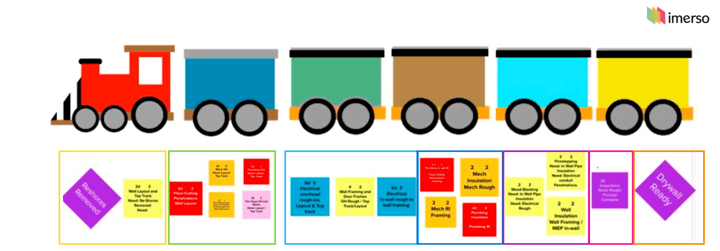
Group activities into Takt Wagons of work packages that can be logically done together in the same work area. The sequence of wagons put together is the Takt Train.
Step 4. Bring it all together.
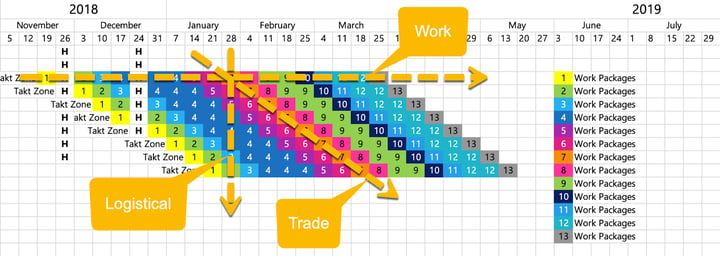
At a glance, this scheduling allows seeing the Work Flow (horizontal) per zone, the Logistical Flow (vertical) across zones, and the Trade Flow (diagonal). Each line represents a Takt Zone, and each column is a unit of Takt time (ie. a month, a week, or a day).
5. BIM & 3D Scanning — Get everyone on the same page
To facilitate your planning, you can leverage methodologies like BIM to create detailed models of the work envisioned by the different disciplines of the project, and how these will fit together on the site.
Design authoring tools like ArchiCAD or Revit allow creating highly detailed and accurate models of your projects. This helps ensure that designs are feasible, practical, and safe before construction begins. Model coordination tools like Solibri allow the models to be brought together and checked for consistency and potential clashes, such as two components occupying the same physical space, reducing the risk of conflicts and inconsistencies during construction.
Augmented Reality (AR) adds digital elements to a live view of the real world on a camera, effectively augmenting your BIM models onto the onsite reality. Popular tools like GammaAR offer mobile apps that onsite users can launch with their phone or tablet.
Reality Capture approaches allow you to easily document the onsite conditions with accurate measurements, and integrate this information into your planning. This can range from simple photos and 360 panorama images, to survey-grade 3D scans with millimetre precision.
There is a variety of 3D scanner devices available to meet your needs and budget, such as the new Leica BLK360 G2 or the NavVis VLX wearable scanner. Check out software like Imerso to make the onsite scanning experience as easy as pressing one button, allowing your teams to deploy the most accurate As-built documentation process without the need for expertise and complex workflows. In your Takt Planning, you can insert Inspection Buffers into your plans to allow routine work documentation with 3D scanning and the detection of any problematic deviations.
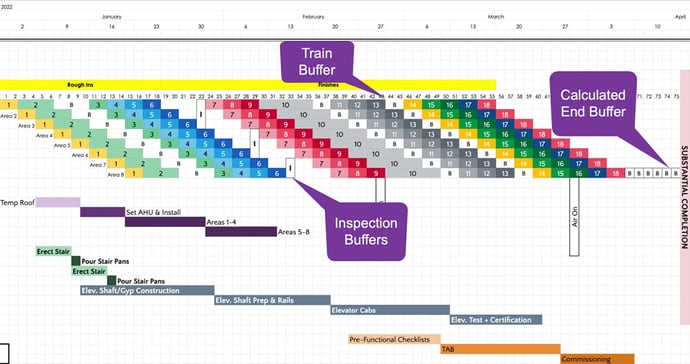
6. Small work batches and prefabrication
In the spirit of the Takt Planning method and the Last Planner System described above, you can find other ways to optimise for repetition and productivity.
Dividing the work sequences into smaller batches is proven to improve Trade Flow across the work areas, and increase team efficiency and predictability. Consider leveraging off-site fabrication and prefabricated elements to further enhance trade flow, allowing your teams to simply assemble the elements into place as these arrive at the site. Tools like Modulize provide automated takeoff, cost estimation, collaborative tendering, and bid generation on a single platform, helping companies identify opportunities to beneficially use offsite construction.
Prefabrication and modular construction are proven to deliver multiple benefits, including:
- Shorter construction periods
- Quality check
- Cost reduction
- Sustainability
- Safety
- Flexibility
- Worker productivity
Other articles on Lean Construction:
Conclusion
The integration of Lean Construction principles in project planning represents a pivotal shift towards a more efficient, collaborative, and client-centric construction industry. By emphasising continuous improvement and enhanced communication, Lean Construction transcends mere methodology, becoming a guiding philosophy driving innovation and excellence.
Embracing Lean Construction isn't without its challenges. It demands a cultural shift, unwavering commitment, and a willingness to challenge entrenched norms. Nevertheless, the rewards are substantial—a streamlined workflow, improved productivity, minimised delays, and ultimately, heightened client satisfaction.
As the construction landscape evolves, the principles of Lean Construction serve as a beacon, illuminating a path toward more agile, adaptable, and value-driven project planning methodologies, reshaping the future of construction projects for years to come.
About Imerso
Imerso is a software platform that combines BIM, Reality Capture, and AI technologies to automate construction site supervision and quality inspections with one simple workflow. We help construction companies cut project risks and delay costs with real-time monitoring of site status and work quality.
For additional reading, check out the 7 Powerful ways of using Imerso to supercharge your construction projects.

.png?width=350&height=147&name=Imerso_Logo_A4_White_Transp%201%20(1).png)
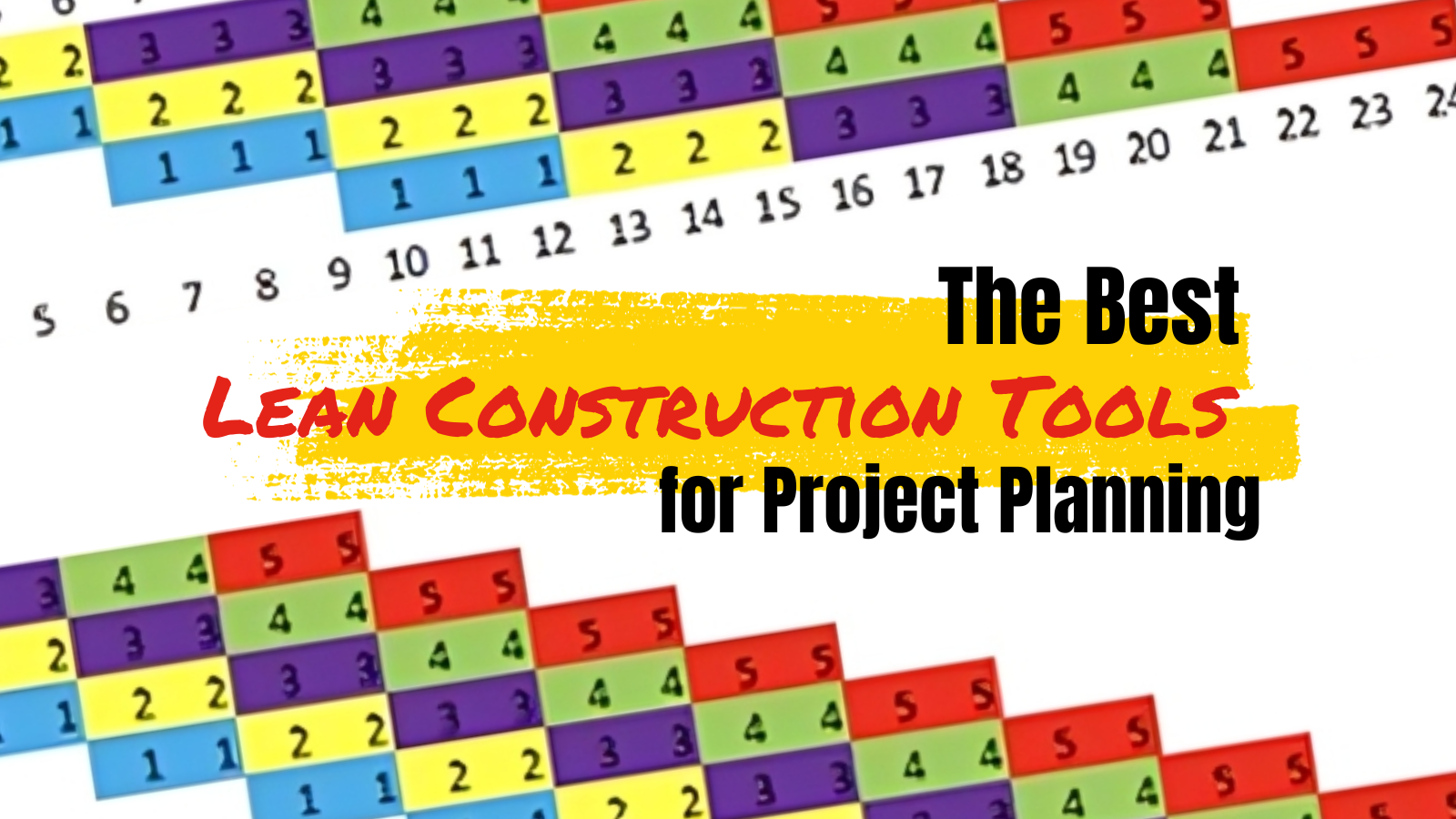

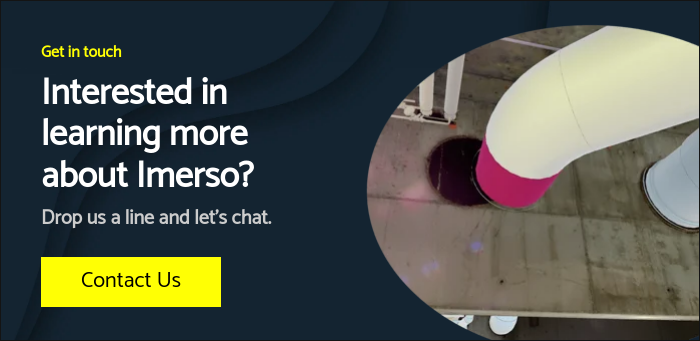
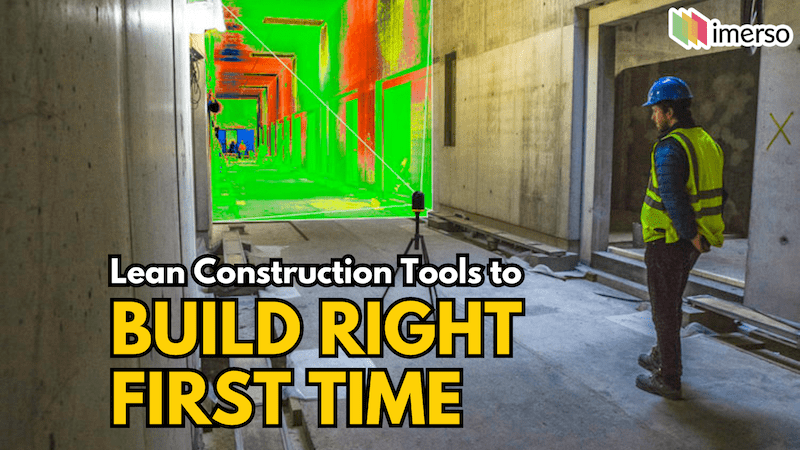
.jpg)
